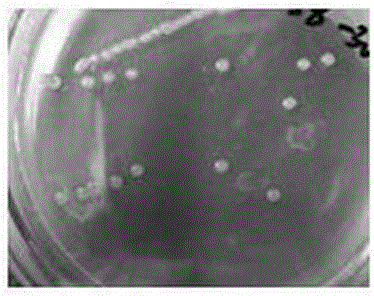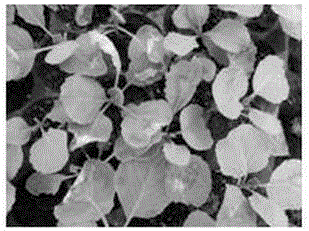Method for screening anti-black rot mutant plants with cabbage free microspores
A technology of black rot and microspores is applied in the field of creating disease-resistant regenerated plants of cabbage by haploid or double haploid cell mutants, which can solve the problems of poor resistance of disease-resistant genes, poor breeding efficiency of breeding time limit, etc.
- Summary
- Abstract
- Description
- Claims
- Application Information
AI Technical Summary
Problems solved by technology
Method used
Image
Examples
Embodiment 1
[0077] Example 1: Screening of Regenerated Plants of Cabbage DHR15-60-6 Disease-resistant Mutants
[0078] 1) Isolation and purification of microspores:
[0079] (1) Put the flower buds of the sterilized cabbage hybrid first-generation variety "Qingan 60", that is, the flower buds whose microspore development is at the mononuclear marginal stage, into a sterile test tube, and use B5 medium containing 140g / L sucrose as the detergent , squeeze the flower buds with a glass rod to free the microspores;
[0080] (2) Filter with a sterile net with a pore size of 50 μm, collect the filtrate in a centrifuge tube, and centrifuge for 3 times, and the pure microspores will settle at the bottom of the centrifuge tube.
[0081] (3) Evenly suspend the microspore precipitate in 10ml of NLN-14 medium with a colchine concentration of 10mg / L, draw a small amount of suspension and count it with a hemocytometer, and adjust the microspore density to 1×10 5 ~2×10 5 pieces / ml.
[0082] (4) Use a...
Embodiment 2
[0097] Example 2: Screening of Regenerated Plants of Cabbage DHR15-HP-1 Disease-resistant Mutants
[0098] 1) Isolation and purification of microspores:
[0099] (1) Put the flower buds of the sterilized cabbage farm variety "Heiye Pingtou", that is, the flower buds whose microspore development is in the mononuclear marginal stage, into a sterile test tube, and use B5 medium containing 140g / L sucrose as the detergent, Squeeze the flower buds with a glass rod to free the microspores;
[0100] (2) Filter with a sterile net with a pore size of 50 μm, collect the filtrate in a centrifuge tube, and centrifuge for 3 times, and the pure microspores will settle at the bottom of the centrifuge tube.
[0101] (3) Evenly suspend the microspore precipitate in 10ml of NLN-14 medium with a colchine concentration of 10mg / L, draw a small amount of suspension and count it with a hemocytometer, and adjust the microspore density to 1×10 5 ~2×10 5 pieces / ml.
[0102] (4) Use a 5ml pipette gun...
PUM
 Login to View More
Login to View More Abstract
Description
Claims
Application Information
 Login to View More
Login to View More - R&D
- Intellectual Property
- Life Sciences
- Materials
- Tech Scout
- Unparalleled Data Quality
- Higher Quality Content
- 60% Fewer Hallucinations
Browse by: Latest US Patents, China's latest patents, Technical Efficacy Thesaurus, Application Domain, Technology Topic, Popular Technical Reports.
© 2025 PatSnap. All rights reserved.Legal|Privacy policy|Modern Slavery Act Transparency Statement|Sitemap|About US| Contact US: help@patsnap.com



